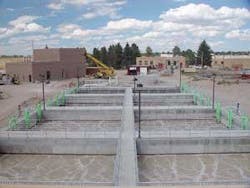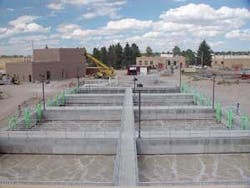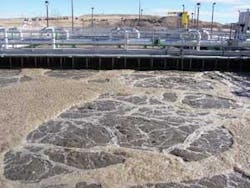Biofilm Treatment Processes Improve Operations at Two Local Plants
By Chandler Johnson & Glenn Thesing
Biofilm processes serve as robust stabilizing procedures for two Wyoming water reclamation facilities, effectively handling significant load and flow changes with minimal negative effect on effluent quality.
Overloaded capacity due to increased population, tighter water quality regulations, and improved treatment processes are primary motivations behind water reclamation facility (WRF) upgrades and expansions. No WRF is immune to these factors. Plant managers and utility boards constantly evaluate plant efficiency as they work to comply with increasingly stringent water quality limits as cost effectively as possible.
Jim Hughes, plant manager for the Dry Creek and Crow Creek WRFs in Cheyenne, Wyoming, is certainly no stranger to these issues. Both Cheyenne plants were recently upgraded and expanded. The driving forces behind these upgrades were new ammonia limits and capacity issues, which presented immediate concerns, as well as the need to respond to any future total nitrogen limits that might be imposed.
“The Department of Environmental Quality determined that we should be tasked with removing some of the ammonia from our effluent, which is discharged into Crow Creek,” Hughes said. “Our Dry Creek facility was also approaching its maximum capacity and needed expanding. It was logical to roll both projects into one.”
For the upgrades, the city selected the AnoxKaldnes™ Hybrid Biofilm + Activated Sludge (Hybas™) Treatment System for its Dry Creek WRF and the AnoxKaldnes Moving Bed Biofilm Reactor (MBBR) for the Crow Creek WRF.
Both the MBBR and Hybas technologies are treatment processes based on biofilm technologies. The processes use plastic media (AnoxKaldnes K1 biomedia) to grow the biofilm, which is retained in reactors using media retention screens while an aeration system is used to provide aeration to allow the bacteria/biofilm to provide the treatment required. Effective biomass within the bioreactor is augmented through growth on the media, and nearly all of the biomass is resident on the media in pure MBBR applications. For applications using the Hybas system, the biofilm is in conjunction with the MLSS in the basin helping to provide the necessary treatment.
“We were initially a little skeptical because we had not seen these technologies put into full-scale use in our region,” Hughes said. “But we decided to pilot test both processes at each plant and the numbers turned out very good.”
Crow Creek MBBR System
The MBBR treatment system was incorporated at the Crow Creek facility to meet the new effluent requirement for ammonia-nitrogen (NH3-N). Prior to its upgrade, the Crow Creek WRF had used rock trickling filters.
“It was basically taking one form of fixed film and substituting it with another and it has worked out very well,” Hughes said.
The process flow scheme uses screens, grit removal, primary sedimentation, biological treatment, and sedimentation for treating the influent wastewater to a monthly average of less than 2 mg/L NH3-N and less than 10 mg/L BOD.
Influent wastewater enters through fine screens and grit chambers to remove any large particles entering the facility. Wastewater then flows to a main splitter box that distributes flow to two parallel MBBR treatment units. MBBR effluent flows to the existing secondary clarifiers for settling out of the MBBR effluent suspended solids.
There are two trains of four MBBR reactors. All the reactors in each train are aerobic reactors for BOD removal and nitrification. The first two reactors concentrate primarily on the BOD contained in the wastewater while the last two reactors perform nitrification. The plant is a pure MBBR, which means that no return activated sludge (RAS) is returned to the front of the plant from the secondary clarifiers.
In all reactors the K1 biomedia is kept in suspension with the aeration system. The overall airflow required to move/mix the media is provided within the actual oxygen required (AOR) for BOD removal and nitrification. Additional air is not required for mixing the media. Effluent from the last MBBR reactor is fed into final clarifiers for settling of the sloughed biomass and total suspended solids (TSS) generated in the MBBRs. The clarified effluent is then sent to ultraviolet disinfection and discharged from the facility.
“The overall design concept incorporated the ability to add anoxic MBBRs ahead of the aerobic reactors, which will then provide us the ability to meet future total nitrogen limits,” Hughes said.
Dry Creek WWTP
The Hybas system was selected for the Dry Creek plant because the technology is designed to retrofit into existing activated sludge plants by adding K1 biomedia to existing reactors to increase the biomass concentration. Combining activated sludge and media in the same reactor, along with proper aeration, provides control over solids retention time and the ability to manipulate the bacterial environment to facilitate different aspects of treatment.
The Dry Creek plant’s Hybas™ reactors are outfitted with an aeration grid along the bottom, an outlet sieve that keeps the media within the tank, and the media itself. Aeration is provided by a diffuser system that also provides the mixing energy for the reactor. The media, wastewater, and air are mixed, providing thorough contact between the biofilm and the wastewater.
The fact that the system could be partially implemented using existing tankage was a cost-saving factor for the Dry Creek plant, according to Hughes. “An existing circular basin was converted into two reactors in series, and retrofitted with K1 type fixed film media, plus one new two-cell square reactor was built on site.”
Effluent from the reactors will either be recycled to the anoxic reactors for allowing some pre-denitrification to occur or effluent will flow into the final clarifiers to settle the MLSS. Settled MLSS is pumped from the clarifier to mix with the primary clarified effluent at the beginning of the process. The improvements to the Dry Creek WRF have boosted its capacity from 7 mgd to 10.5 mgd.
“Prior to the upgrade, we had the process control for activated sludge down to an art and we were concerned that the addition of the media would present new process control issues. But what it actually did was stabilize the system,” Hughes said. “For example, we had a failure in our primary digester and within about a three-to-four month period the activated sludge levels to the Hybas™ system went from 300 mg/l to 6,000 mg/l. But during this time, our effluent figures varied only slightly. The biofilm media was the stabilization factor.”
The Results
Cheyenne is currently the only place in the world where both Hybas and MBBR plants are being operated in one municipality. Running the two plants with very similar processes “side by side” has granted Hughes and his operators some unique insights into the Hybas™ and MBBR systems.
“We deal with the activated sludge portion of our treatment exactly the way we did in the past – we waste, we do our MCRTs to determine the sludge age, but with the biofilm treatment portion of it we don’t really have to do much other than keeping our dissolved oxygen (DO) at optimum levels,” Hughes said. “Back when we ran our original activated sludge system, if an operator made an error in a calculation or wasted too much or too little, it could upset the plant and removal efficiencies would quickly drop off. But what we have found at both plants now with the biofilm media is that it stabilizes the treatment process. If we have higher than normal flows, or higher than normal loadings, it just deals with it without any additional process control on our part. We don’t have to make any drastic changes, we simply watch the DO and make sure it’s kept in the optimum range.”
The Test
The true test of the two biofilm treatment systems comes each year with Cheyenne Frontier Days, a 10-day event that takes place during the last full week of July. During this time the population explodes from 50,000 to as much as 150,000, and plant loadings can double or even triple in as little as one day. By the same token, when the event ends and everyone leaves, loadings drop down to normal again within a 24-hour period.
“With our former treatment systems, preparation to accommodate such large load and flow changes began weeks in advance,” Hughes said. “But with the biofilm treatment systems, the plants run as usual, with no additional preparations or changes in operation. Our plants readily handle the drastic changes in loading with little change in the effluent. We can graph the effluent at both plants prior to and through Frontier Days and we can’t tell by the numbers that the event even occurred. The processes are that stable – they simply absorb those drastic load changes.” WW
About the Authors:
Chandler Johnson is vice president, AnoxKaldnes™, a Veolia Water Solutions & Technologies North America product line marketed by Kruger, Inc. in municipal applications. Glenn Thesing is Product Manager/AnoxKaldnes™ for Kruger Inc., a Veolia Water Solutions & Technology company.


